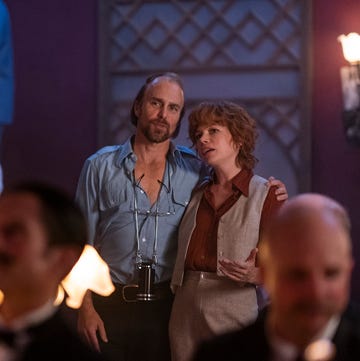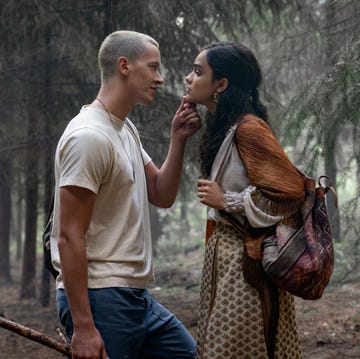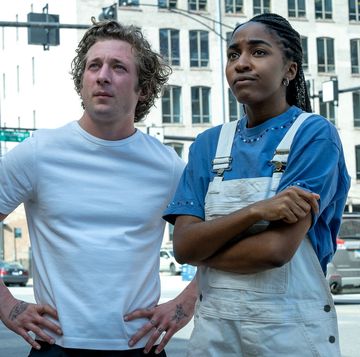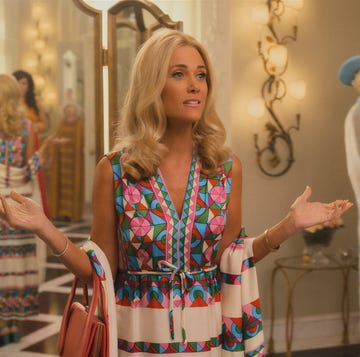The FX miniseries Fosse/Verdon, which debuted last week and airs its second episode this evening, aims to be a lot more than a straightforward biography of two Broadway legends. In telling the story of director Bob Fosse (Sam Rockwell) and his muse, wife, and frequent collaborator Gwen Verdon (Michelle Williams), the show also digs into the gender dynamics of creative work, and the reasons why—despite the fact that they were clearly a team—Fosse's name is so much more widely known than Verdon's.
Here are five things to know about Gwen Verdon ahead of tonight's second episode of Fosse/Verdon.
1) She suffered from rickets as a child.
Verdon's legendary career as a dancer is all the more extraordinary in light of the fact that she suffered from rickets as a child, a disorder that causes the softening and weakening of bones in children (usually due to vitamin D deficiency). The disorder left her legs so badly misshapen that she spent her early years in orthopedic braces. Her mother put her in dance classes at the age of two to strengthen her muscles, not realizing that this would be the beginning of a long and fruitful career.
2) She once made a curtain call wearing only a towel.
A breakthrough moment in Verdon's career came in 1953, when she was cast in Cole Porter's Broadway musical Can-Can. Her performance during the show's ballet number, "The Garden of Eden," garnered a seven-minute standing ovation in the middle of the first show. The applause was so prolonged and relentless that she eventually had to leave her dressing room—wearing only a towel—to take her bow. The role ultimately won Verdon her first Tony Award.
3) She originated one of Broadway's most iconic roles.
Verdon's collaboration with Fosse began before they were married, and continued long after they split. The pair worked together on numerous musicals including Sweet Charity, Damn Yankees, and Chicago, where Verdon originated the lead role of Roxie Hart. The latter would ultimately be Verdon's final Broadway performance, and was described by The Los Angeles Times as a role that "displayed her ability to make the worst possible behavior into a form of social parody, in which she remained delectably, inimitably winsome."
4) She never divorced Fosse after their split.
Fosse's extramarital affairs put a strain on the couple's marriage for many years, and the breaking point came in 1971 during the production of Cabaret. According to Sam Wasson's biography Fosse, Verdon walked in on Fosse with "a couple of German girls" during production on Cabaret, and the couple separated shortly after.
Despite their split, Verdon remained close with Fosse and collaborated with him on many more projects—most notably Chicago in 1975. The couple never divorced, and Verdon was with Fosse when he collapsed from a fatal heart attack in Washington D.C. on September 23, 1987. The couple were still married, and Verdon never remarried after Fosse's death.
5) She had a close relationship with Fosse's longtime partner Ann Reinking.
Following his split with Verdon, Fosse's longest-running relationship was with the dancer and actress Ann Reinking, who was his partner for several years during the 1970s. Reinking appeared in Fosse's semi-autobiographical film All That Jazz, playing a role based loosely on herself. Verdon and Reinking forged a close relationship of their own, which endured after Fosse's death in 1987. In the last years of her life, Verdon and her daughter Nicole Fosse collaborated with Reinking on the Broadway revue show Fosse, which recreated and celebrated Fosse's work.
In a touching interview with The Telegraph in 2000, Verdon and Reinking women were eager to play up one another's accomplishments as dancers. "You know, Gwen is the best there is," Reinking said. "You should've seen her dance. She was, still is, the most exceptional performer." Verdon, meanwhile, was quick to respond that, "Annie is the most marvelous dancer. Annie and I don't really dance alike. We can, but I can't do what Annie does. She has a great stretch, much more of a balletic background. That pushed Bob to choreograph in a different way than he would choreograph for me."

Emma Dibdin is a freelance writer based in Los Angeles who writes about culture, mental health, and true crime. She loves owls, hates cilantro, and can find the queer subtext in literally anything.














